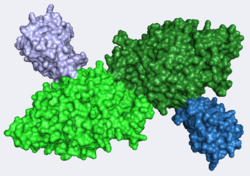Neurexins (
NRXNs) and
Neuroligins (
NLGNs) are synaptic cell-adhesion molecules that form a connection between presynaptic and postsynaptic neurons at synapses. NLGNs, of which NLGN1-5 are the best characterized, are endogenous NRXN ligands.
[1] Upon binding NRXN, NLGNs mediate signaling across the synapse, recruit neutrotransmitter receptors, and shape neural networks and synaptic functions. Early experiments validated that NLGNs function at synapses by showing that NLGN expression in non-neuronal cells can cause presynaptic specializations to form on co-cultured neurons. The same is true for NRXNs which formed postsynaptic specializations.
[2] Subsequent analysis of gene-knockout mice surprisingly revealed that NLGNS and NRXNs are essential for synaptic function and organization, although do not appear to be critical for synapse formation.
[3]
Neuroligin-Neurexin & Autism
Experimental results from the past 10 years have revealed that loss of Neuroligin reduces inhibitory synapse function, indicating that inhibitory synapses rely heavily on neuroligins compared to excitatory synapses.[1] It was also discovered that overexpression of neuroligin-1 leads to increased excitatory transmission whereas overexpression of neuroligin-2 leads to a marked increase in inhibitory transmission.[2] This was an astonishing discovery as Autism Spectrum Disorders (ASDs) have long been attributed to perturbations in the Excitatory/Inhibitory (E/I) synaptic signal ratios within the brain. Excitatory synapses release excitatory neurotransmitters like glutamate while inhibitory synapses release inhibitory neurotrasnmitters like gamma-aminobutyric acid (GABA). Knockdown studies have validated that the selective knockdown of NLGNs creates a significant E/I transmission imbalance, possibly altering the brain’s oscillatory rhythms.[3][1] As Sudhof et al. point out, a major reason for the difficulties in understanding cognitive diseases is that they arise from subtle changes in various subsets of synapses as opposed to obvious impairment of all synapses.[2] The altered E/I ratios associated with NLGN dysfunction may be an example of such a “subtle change”. Indeed, mice with non-functional mutated NLGN4 exhibit social interaction and communication defecits that are reminiscent of human ASDs.[4] Of particular interest are those NLGN3 mutations like R451C in which mice have impaired social ability but elevated learning capacity. These manifestations are reminiscent of “savant” syndrome.[3] In all, seven point mutations, two translocations and four multi-base deletions in the NRXN1 gene were detected in patients with autism.[2] These mutations however were only found in a small percentage of Autism patients and are occasionally present in non-symptomatic siblings. Thus, these mutations may only increase the chance of autism rather than actually causing it.[5]
Structure of Neurexin
There are two , α and β. While α-NRXNs are much larger than β-NRXNs, both contain a single LNS (Laminin, NRXN, sex-hormone-binding globulin domains) domain. Alternative splicing at five positions within the NRXN gene creates thousands of NRXN isoforms which specify an interaction “code” at synapses that varies by neuron location and activity.[2] All NRXN isoforms are found on presynaptic neuron surfaces and have the same comprised of 14 beta sheets. The alternative splicing only , including sheets 1, 2, 13 & 14 and the lone alpha helix in the LNS domain.[6]
Structure of Neuroligin
The , which bind to the LNS domains of both alpha and beta NRXNs, are that is homologous to acetylcholinesterase (AChE).[2] Neuroligin-4, which is expressed on the surface of postsynaptic neurons, contains a twisted . Three between residues Cys110-Cys146, Cys306-Cys317, and Cys476-Cys510, stabilize the structure. Neuroligins readily . Nearly 100% of the dimer with the most unique feature being a ().[5] The , which in Acetylcholinesterase contains the active center and oxyanion hole, is catalytically inactive due to a Serine to Glycine substitution , which is typically part of AChE’s catalytic triad. The (Residues Cys110-Cys146) forms one rim of the central pocket and is a homolog of the lid found in lipases of the α/β-hydrolase fold family. This Cys-Loop blocks the entry of substrate to the central pocket and provides stability to the NLGN structure.[5]
Neuroligin-Neurexin Interaction
through its to the of the NLGN-4 molecule, . The NRXN-NLGN interface is established by both indirect and direct interactions. Indirect interactions include by residues Asp 137, Asn 238, Val 154 and Ile 236 of NRXN-Beta1 and residues Gln 359 and Gly 360 of NLGN-4. between NRXN and NLGN include extensive hydrogen bonding and Van der Waals contacts as well as between residues NRXN-Arg 109 & NLGN-Glu 270 and NRXN-Arg232 & NLGN Asp 351. The vast majority of these interactions are conserved among all neuroligin types.[5]
Mutations Leading To Neurodevelopmental Disorders
Several (R437C (451 in NLGN 3), G99S, K378R, & V403M) within NLGN have been positively linked with Autism Spectrum Disorders. Although these mutations are remote from the NLGN-NRXN interface, conclusions can be drawn as to their impact on the function of NLGN. , a mutation shown to result in “savant” like attributes in mice, is believed to increase retention of NLGN in the endoplasmic reticulum preventing correct positioning at the cell surface. It could also disrupt a (Asp 388, Asp 486, Glu 434, and Lys 338) through Trp 484, which likely play an important role in processing events. is believed to affect correct folding of the C-terminal domain of NLGN and prevent formation of the functional dimer. The which interacts with the through Van der Waals contacts could disrupt the Cys-loop deleteriously impacting NLGN structural integrity. These mutations do not entirely disrupt NLGNs interaction with NRXN, but do impact NLGN in the subtle ways from which autism likely arises.[5]

